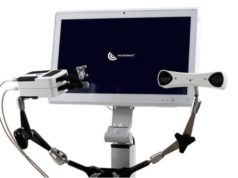
Merit Medical Systems has announced the expansion of its biopsy portfolio, with the release of five new manual bone biopsy systems. According to a company press release, each of the systems has been specifically designed to optimise diagnostic yield in specialised settings, and, collectively, they provide multiple options for use in a wide variety of applications.
Featured in the new line-up are the Madison and Huntington bone biopsy systems. The direct access Madison features a trocar-tip stylet that can be introduced through the cannula to assist with initial bone entry. The cannula also supports the use of a drill insert that helps traverse hard bone for small cortical abnormalities in axial and appendicular cases. The Huntington is designed with a tri-angled tip and longitudinal groove that both maintains accuracy even in oblique approaches and functions as a collection channel for tissue evacuation upon first contact in hard bone procedures and sclerotic lesions.
The patented perforating cannula included in the Madison and Huntington systems facilitates greater accuracy of placement through dense bone tissue. The stylet of these systems can easily be exchanged for a drill insert without losing the introducer cannula’s place in the bone; when used in conjunction with a drill, the edges of the perforating cannula simultaneously cut around the drill as the tip bores through the bone.
“The range of biopsy systems allows the physician to choose the needle best adapted to the bone density prior to or during the procedure,” says Jean-Denis Laredo, chief of the Radiology Service, Lariboisière Hôspital, and professor of Medicine at the Public Hospital of Paris, University of Paris-Diderot, France. “Having a Seldinger-inspired guide wire approach to the spine assists both experienced and younger radiologists in safely placing a larger needle. The biopsy is almost achieved once the introducer needle is against the target. This also provides a better anaesthetic for the patient, and less radiation caused by repeat scanning.”
In addition to the Madison and Huntington systems, Merit is also introducing the Madison Mini for small rounded bones that have little soft-tissue surroundings; the Westbrook, designed to reach superficial lesions in soft- or normal-density bone; and the Kensington bone biopsy system, which was created for deep bone, upper spine and narrow access procedures. The Kensington is used with the Seldinger-inspired guide wire approach.
All of the systems utilise the Preston bone biopsy needle, which is constructed with clockwise-cutting trephine teeth to support true cylindrical tissue retrieval and use even in sclerotic and blastic lesions. The systems also offer comfortable-grip handles that lock together to allow for more manual pressure if necessary, and depth stoppers to give a visual guide for biopsy needle protrusion beyond the introducer.
“The expansion of our biopsy portfolio allows us to better serve the needs of our customers and underscores Merit’s belief that offering a wide range of products gives practitioners a fuller set of options for instrument selection,” comments Fred Lampropoulos, chairman and CEO of Merit Medical.













